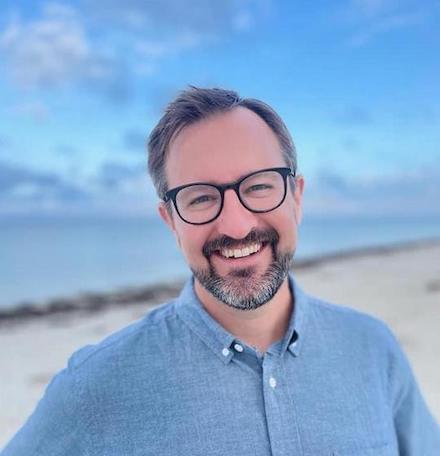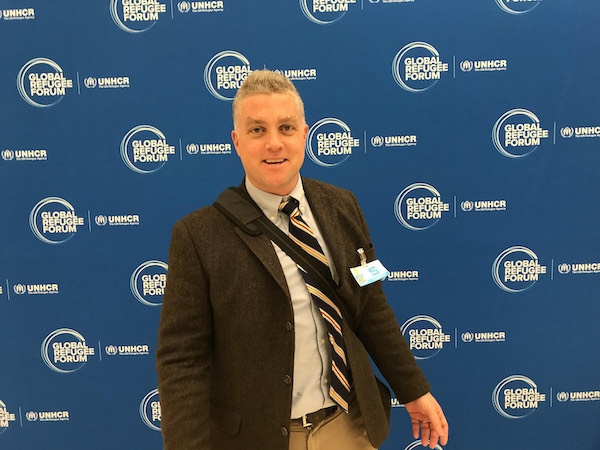History Department Welcomes Two New Faculty Members
The Loyola History department is pleased to welcome two new faculty members: Dr. Christopher D. Cantwell (Assistant Professor of Digital Public History) and Dr. Noah Sobe (Professor of History). Below, they introduce themselves to the Loyola History community.
Dr. Christopher D. Cantwell

Can you introduce yourself and tell us a bit about your background and career, especially in Public History and Digital History?
I’m an Illinois native who began his career in Chicago, so I am very excited to return. I got my PhD in American history from Cornell University, but I moved to Chicago in 2006 after passing my comprehensive exams in order to conduct research and gain additional kinds of professional experiences. This eventually led to a stint as the assistant director of what was then called the Scholl Center for American History and Culture at the Newberry Library. In this role I helped to develop a number of digital augmentations for the library’s public programs, including a crowdsourced transcription project, digitized text corpora, and virtual exhibits. From there I went on to help run the public history programs at the University of Missouri-Kansas City and the University of Wisconsin-Milwaukee, which were a lot of fun. But I am very glad to be returning to a place I call home.
You are the curator of the digital exhibit Gathering Places: Religion and Community in Milwaukee. Can you tell us more about this project, as well as the future of the project?
Gathering Places really has two sources of inspiration. First is an observation Diana Eck long ago made as the founder of Harvard’s Pluralism Project. Students, she noted, are really at the vanguard of America’s emerging religious landscape, and they are perhaps best suited to understand it. The second was what I saw as the frustratingly slow pace with which the field of religious studies was adapting digital humanities methods. And so, Gathering Places took shape to address both concerns. The project has students partner with a local religious community over the course of a semester in order to document their past through archival research, architectural profiles, oral histories, podcasts, and ethnographies. All of this material then gets published online on a dynamic, map-based interface that allows visitors to explore the evolution of a city’s religious landscape over time. The project has been a lot of fun. We’ve explored Zen meditation centers that meet in refurbished autobody garages, and chart how places of worship have gone on to become things like art galleries, crossfit gyms, and even breweries.
The project took shape while I was teaching in Milwaukee, and the title “Gathering Places” comes from a translation of the Potawatomi word from which the city of Milwaukee derives its name. But it quickly became clear that what we were doing in Milwaukee could be reproduced elsewhere. Milwaukee is not unique in the multiplicity of its religious life, and the concept of a “gathering place”—looking at how people gather in many ways in relation to this thing we call religion—can actually provide a more capacious theoretical framework for studying religion in the urban environment, as previous studies have used terms with a lot of Judeo-Christian baggage like “church history” or “places of worship.” And so, the hope is to transform Gathering Places from a project that looked at just one city into a platform that provides a space where community partners from across the globe can explore the particularities of their religious environment.
What excites you most about teaching at Loyola?
I used to work alongside Loyola interns while I was at the Newberry, so I’m excited to work with them on this side of the relationship. The chance to contribute to a public history program as storied and as important as Loyola’s is really a remarkable opportunity.
What’s one (non-academic) thing you think the Loyola community should know about you?
I guess the one thing I would say is that outside of my family, the thing that sustains me is hockey. I play the game, coach my kids, and go watch it when I can. When so many academic projects take years and years to develop, it’s nice to have something where the only thing you have to worry about is your next sixty-second shift.
Dr. Noah Sobe

Can you introduce yourself and tell us a bit about your background and career?
I have been a classroom teacher and did my graduate work at Teachers College, Columbia University (MA) and my PhD at the University of Wisconsin Madison. Across the 1990s I taught and worked with teachers in several areas of East/Central Europe, where I first became fascinated with the international and transnational circulation of education policies and practices. This led me to study the history of education and I have published a book on Yugoslav education in the 1920s and 30s, as well as articles and chapters on the progressive education movement in the United States and elsewhere. From 2012-18 I served on the Executive Committee of the International Standing Conference on the History of Education (ISCHE). My work also takes into the field of comparative and international education and I am a past president of the Comparative and International Education Society (CIES) as well as co-editor of the journal European Education. I've also done a fair amount of work on the history of childhood and the history of emotions and am presently at work on a book about the history of boredom in school.
You recently spent three years working for the Future of Learning and Innovation team at the UNESCO headquarters in Paris. What was that experience like?
It was fascinating to be at an international organization that, like a university, is very much a knowledge-producing organization. Of course, with its ambassadors and as part of the UN system, UNESCO operates quite differently from a university. I learned a tremendous amount about the global education landscape and the ways global education policy gets written and debated. My role was to lead on the research and drafting of a major report on the futures of education that came from an international commission chaired by the President of Ethiopia. That report, Reimagining our futures together: A new social contract for education came out in 2021 and since then it has been very exciting to see ways it has been taken up in educational conversations around the globe.
What excites you most about teaching in Loyola’s History department?
I'm thrilled to be joining the History department. As I've argued in a recent blog piece "A new social contract and a new grammar of schooling," I believe it is essential to bring a historical perspective into any conversations on what we want our futures to be. I'm excited to be teaching Global History and bringing in a childhood and youth lens. The scholars and students in Loyola's History department are impressive and inspiring and it's an honor to be joining.
What’s one (non-academic) thing you think the Loyola community should know about you?
This may not be non-academic enough! but I've become a great fan of speculative fiction recently. Both books like Laurent Binet's Civilsations which imagines an alternative global history whereby the Inka and Aztecs conquer -- and come to blows in -- Europe, as well as Kim Stanley Robinson's climate fiction in books like New York 2140.


